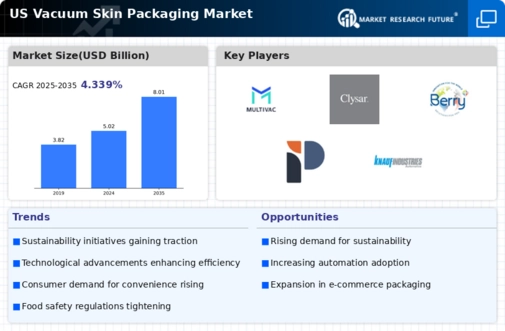Expansion of Retail Channels
The vacuum skin-packaging market is poised for growth due to the expansion of retail channels, particularly in the e-commerce sector. As online grocery shopping continues to rise, the need for effective packaging solutions that maintain product integrity during transit becomes paramount. Vacuum skin-packaging is well-suited for this purpose, as it minimizes spoilage and enhances product presentation. Recent statistics suggest that e-commerce grocery sales in the US are expected to reach $100 billion by 2025, creating a substantial opportunity for vacuum skin-packaging solutions. Retailers are likely to adopt these technologies to ensure customer satisfaction and reduce return rates, thereby driving market growth.
Regulatory Support for Food Safety
The vacuum skin-packaging market benefits from increasing regulatory support aimed at enhancing food safety standards. In the US, agencies such as the FDA and USDA have established guidelines that encourage the use of advanced packaging technologies to ensure food safety and quality. This regulatory environment fosters innovation within the vacuum skin-packaging market, as manufacturers are motivated to adopt these solutions to comply with safety regulations. The market is expected to witness a surge in demand as food producers and processors prioritize compliance with these standards, thereby driving growth in the vacuum skin-packaging sector.
Consumer Preference for Convenience
The vacuum skin-packaging market is significantly influenced by the growing consumer preference for convenience in food products. As lifestyles become increasingly fast-paced, consumers are gravitating towards ready-to-eat and easy-to-prepare meals. Vacuum skin-packaging offers an effective solution by providing products that are not only fresh but also easy to handle and store. This trend is reflected in market data, which indicates that convenience-oriented packaging solutions are gaining traction, with a projected increase in market share of around 8% over the next few years. Consequently, manufacturers are likely to invest in vacuum skin-packaging technologies to cater to this evolving consumer demand.
Technological Innovations in Packaging
The vacuum skin-packaging market is benefiting from ongoing technological innovations that enhance packaging efficiency and effectiveness. Advances in materials science and packaging machinery are enabling manufacturers to develop more sustainable and user-friendly vacuum skin-packaging solutions. For instance, the introduction of biodegradable films and improved sealing technologies is likely to attract environmentally conscious consumers. Market analysis indicates that the adoption of such innovations could lead to a 10% increase in market penetration over the next few years. As companies strive to differentiate their products in a competitive landscape, the vacuum skin-packaging market is expected to see a surge in innovative offerings.
Rising Demand for Freshness Preservation
The vacuum skin-packaging market is experiencing a notable increase in demand driven by consumers' desire for freshness preservation. This method effectively extends the shelf life of perishable goods, which is particularly appealing in the food sector. According to recent data, the market for vacuum skin-packaging solutions is projected to grow at a CAGR of approximately 6.5% over the next five years. This growth is largely attributed to the rising consumer awareness regarding food waste and the need for longer-lasting products. As retailers and manufacturers seek to meet these consumer expectations, the vacuum skin-packaging market is expected to see enhanced adoption across various food categories, including meat, seafood, and dairy products.
















Leave a Comment